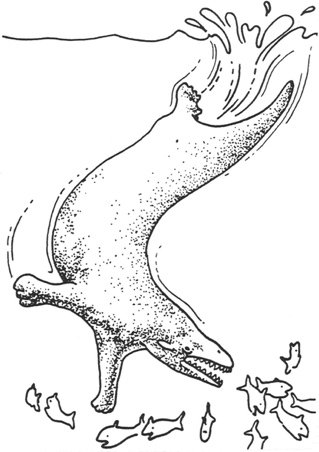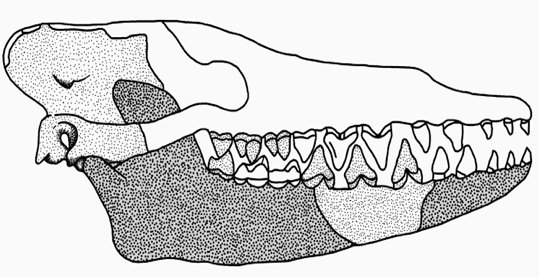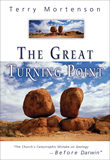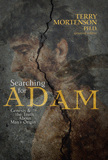
Transitional Fossils: Evidence for Evolution?
A response to Dr. Todd Wood’s arguments for transitional fossils
In previous articles in this series (where we are expressing our concerns about evolutionary claims and ways of thinking that are being affirmed or utilized by young-earth creationists), we have discussed claims about feathered dinosaurs, walking whales, and ape-men. Here, we want to shed more light on the fossil evidence and creationist statements that concern us.
Dr. Todd Wood is a young-earth creationist who provocatively says there is “gobs and gobs of evidence for evolution.” A previous article has examined some of his thinking on this and what he means by “evidence” and “evolution.” In this article, we want to examine further what he has published about transitional fossil forms as evidence of evolution. We will focus on two popular-level books by Dr. Wood: The Quest: Exploring Creation’s Hardest Problems (2018) and The Fool and the Heretic: How Two Scientists Moved Beyond Labels to a Christian Dialogue About Creation and Evolution (2019), coauthored with theistic evolutionist Dr. Darrel Falk.
In this article, we want to examine further what he has published about transitional fossil forms as evidence of evolution.
At the beginning of The Quest, Dr. Wood says, “To be honest, until people pointed it out to me, I never knew that my way of thinking was so difficult. . . . I’ve also discovered that most people are confused (and a little threatened) by the way I think and talk about creation and evolution.”1 Well, we are not threatened, but with a strong effort to try to understand and be accurate, we are concerned about some of his thinking and talking about evolution. We therefore quote extensively from what he has written as we express our concerns and criticisms.
In The Quest, which we know has been used as a textbook in at least one YEC university, Dr. Wood discusses “Lucy,” the famous supposed ape-woman.
Is Lucy the “missing link,” an ape ancestor of all modern human beings? I don’t know. No one could possibly know that, and there’s not really any way to test for it either. But Lucy does have characteristics of both modern humans and modern apes in one body. Lucy is an intermediate.2
This is Wood’s clear statement about Lucy in the text. But tucked away in the endnotes in the back of the book, which most readers don’t read, Wood says, “In case you are wondering, the evidence so far is pretty decisively in favor of Neandertals and Homo erectus being human and Lucy (Australopithecus afarensis) being a non-human ape.” He’s right about those three creatures, but he contradicts his verdict on Lucy and his claim about ignorance that he made on page 26. But he continues,
If you read early creationist literature, they make it pretty clear that nothing will ever be found that bridges the gap between human and non-human. I think that’s true, but I also think we need to make sure we’re clear about what it means. I think there is no half-human, half-animal creature that was part of our evolution from apes. But it’s hard to look at Lucy . . . and say that there were never creatures that had characteristics of both living humans and living apes. In other words, there are creatures that might look kind of like intermediates, and if I were inclined to accept evolution, then I could see why people would think that these are our ancestors.
Okay, so Lucy is not part of the story of our evolution from the apes. But Wood thinks that she looks part-human and part-ape (well, maybe not 50-50) and that she looks like an intermediate. But he doesn’t know and nobody can know for sure, says Wood. This is unhelpful confusion. He continues on the same page,
I know that’s hard to read. It’s hard to write. It’s traitorous, really, like confessing a murder. I am basically conceding the evolutionary theory successfully predicted the existence of intermediate forms. There really are things that look sort of like “missing links.” It’s not just humans either. There are dinosaurs with feathers that sort of look like they could be the ancestors of birds. There are reptiles that have jaws like mammals that sort of look like they could be the ancestors of mammals. There are fossil whales with hind legs that sort of look like they could be the ancestors of modern whales. There are even fish with bony fins that sort of look like they could be the ancestors of all the bony land animals. The list goes on and on and on.
These above are some of the creatures that look like “missing links.” And the list could go on and on, he says. The evolutionists have “successfully predicted the existence of intermediate forms.”
After accurately summarizing that Genesis 1 teaches that God created different kinds of creatures according to their kind, explaining that God made Adam and Eve distinct from the animals and that Adam and Eve disobeyed God, resulting in God’s curse on creation, and that Paul and the early church fathers affirm that Genesis is literally accurate on these points, Dr. Wood then goes on to say this:
And now we have evolution, which tells us that there was no special origin of humanity. There was no time when our ancestors numbered less than thousands. And there was definitely no time when our ancestors didn’t experience death, just like we do. Don’t believe them? Check out all those intermediate forms!
On the other hand, evolution seems kind of enticing, doesn’t it? We can quibble about whether this or that fossil is a good representation of the animal ancestors of humans, but on the whole, the existence of these intermediate forms sure does look like a kind of evolution. On the other hand, we have 2000 years of Christian history, testimonies of lives radically changed by the power of God in Christ Jesus, and the theological identity handed down to us in a chain of Christian thought and writing back to the apostles in Jesus himself. Hopefully, you can point to your own life and see God at work there too.3
Notice the move here. It sure looks like there are lots of transitional fossils, but no worries. We have church history and the subjective experience of the changed lives of Christians, including Dr. Wood’s spiritual experience. Of course church history is important, as is our life-changing relationship with Christ. But that is not the way to deal with the claims of “all those intermediate forms.”
And if all we do is “quibble” (make a “petty or carping criticism; a minor objection”4) about this or that fossil to see if it is a transitional ape-man, then of course we will conclude that “on the whole” it “sure does look like” human evolution happened. But David Menton and Marvin Lubenow (both experts on this question) didn’t just “quibble” over fossils in their chapters in the book Searching for Adam. They presented powerful, in-depth, paleontological evidence (along with other kinds of evidence by their coauthors) refuting the gospel-subverting lie of human evolution. But Wood continues on the next page,
So what do we do? There’s that question again. On the one hand we have science that seems so powerful and persuasive, and on the other hand, we have a strong tradition of faith and a personal history of our redeemer. We have two reliable witnesses, but their testimony is very different. I think we have a couple of options.
First, we could re-examine the Bible one more time. I don’t know if that’s going to do much for us here, but it never hurts to read the Bible, right? Let’s say for the time being though that we’ve understood the scripture correctly. Now what?
Second, we could reject the Bible. Honestly, I think that’s drastic and wrong. I pray that you do, too. God has been faithful and showered me with undeserved grace and kindness in my life, and I am fully convinced that he will continue to do so in the resurrection, when I see him face-to-face. Abandoning the faith is not an option.
Third, we could reject the science. This is attractive to a lot of people, especially those who might not understand all the details. I don’t want to discount this option for individuals who really aren’t trained in science. If thinking or learning about human evolution makes you upset, don’t do it. That’s easy, right? On the other hand, that’s a terrible strategy for the church as a whole. Science has a great deal of cultural power in our modern world, and science has been immensely successful in many ways. We don’t want to just reject it outright, and I don’t think we should even discount its testimony, even on human evolution. Like it or not, science is credible even if it’s not always right, and we as the church, the body of Christ, need to take it seriously.
Fourth, we can hold fast to our confession that God’s word is true and conclude that there must be some sense to be made of the natural world in the light of the Bible. In other words, the conflict that we see must be in our heads. We’re ignorant, or we’ve made a mistake. I’ve already mentioned that we could re-examine the Bible, but we can also re-examine the science as well. That can be very difficult, of course, because science requires such specialized training and knowledge. Nevertheless, this is a clear way forward on our quest to understand: We [sic] acknowledge that there is a truth to be found that includes both our experience with God and our experience with creation (that’s the goal of our quest), and we commit to finding it. Is that realistic? Can we really figure this stuff out? Or am I just being arrogant?5
But Dr. Wood left out the fifth, correct option. Look carefully at the evolutionist claims. Look for antibiblical, naturalistic (atheistic) assumptions driving evolutionary thinking and watch for unsubstantiated just-so claims. And today (or in 2018, when Wood’s book was published), do some research on the leading creationist websites for articles published over the last few decades that will help you see any lies or deceptions or mistaken evolutionary interpretations. It’s puzzling and troubling that in neither of the books under consideration does Wood ever recommend the websites of AiG and other YEC organizations, nor does he point his lay or student readers to any specific popular-level articles on these sites. Why not?
There is only one truly reliable witness about the origin and history of the creation: the Bible, which is the eyewitness account of the Creator.
It is also a little troubling that Wood repeatedly refers to “science,” but with different meanings that only confuse the reader. He says science “seems so powerful and persuasive” and “has a great deal of cultural power,” i.e., the statements of scientists—especially the majority of scientists—have great influence on people’s thinking. Or, science “requires such specialized training and knowledge,” i.e., to do scientific research or understand technical literature requires this training and knowledge. Or, “we could reject the science,” by which he likely means in this context that we can decide to reject the claims of evolutionary scientists. Or, “we can also re-examine the science,” by which he means we can scrutinize the evidence and reasoning of the evolutionists. This vague and diverse use of “science” is as confusing as when evolutionists misleadingly say, “Evolution is science, and creation is religion.”
In these two books by Dr. Wood, he also never distinguishes between experimental science (which produces technology or finds cures for disease) and historical science (which tries to reconstruct the unobservable, unrepeatable past on the basis of the evidence we observe in the present).6 Most Christians don’t understand the significant difference, which is why they are deceived into believing that “science” has proven evolution.
It is also disturbing that Dr. Wood says we have “two reliable witnesses”: “science” and “a strong tradition of faith and a personal history of our redeemer.” True, 2,000 years of church history strongly supports young-earth creation as the correct understanding of Genesis. Apparently, by “a personal history of our redeemer,” Wood means a Christian’s personal experience with Christ. Elsewhere in this series we have expressed our concern about Dr. Wood’s apologetic use of subjective experience. But given the ups and downs of life, human fallibility, and sin nature, a Christian’s subjective experience is certainly not a reliable witness for thinking correctly about evolution. As for “science,” it is most certainly not reliable, since “science” (i.e., scientific consensus, the majority view) has been wrong uncountable numbers of times on all kinds of scientific questions. There is only one truly reliable witness about the origin and history of the creation: the Bible, which is the eyewitness testimony of the Creator. And that eyewitness must be used to evaluate every scientific truth-claim.
So, Are There Transitional Forms in the Fossil Record?
Are there transitional forms in the fossil record that confirm evolution? Namely, are there lots of fossils showing that all living and all fossilized plants, animals, people, and microbes are related to a single common ancestor, as Darwin and virtually all evolutionists today believe and dogmatically proclaim to the world? Are there, for example, creatures that are half-fish and half-amphibian or half-reptile and half-bird? Are there creatures that are 90% reptile and 10% bird? And then a little higher in the rock record, are there creatures that are 80% reptile and 20% bird, and then higher up creatures that are 70% reptile and 30% bird, and so on until we find 100% birds higher in the rocks? We should find thousands and thousands of transitional fossils if evolution and millions of years are true. So is there fossil evidence of transitional forms that strongly supports the theory of microbe-to-microbiologist evolution?
In his 1859 book, Origin of Species, Darwin devoted a whole chapter to the fact that the fossil record did not support his theory. He wrote,
But just in proportion as this process of extermination has acted on an enormous scale, so must the number of intermediate varieties, which have formerly existed on the earth, be truly enormous. Why then is not every geological formation and every stratum full of such intermediate links? Geology assuredly does not reveal any such finely graduated organic chain; and this, perhaps, is the most obvious and gravest objection which can be urged against my theory. The explanation lies, as I believe, in the extreme imperfection of the geological record.7
Darwin predicted that more fossil research would one day supply the evidence to confirm his theory. In 1960, Carl O. Dunbar, then Professor Emeritus of Paleontology and Stratigraphy at Yale University, and former Assistant Editor of the American Journal of Science said, “Although the comparative study of living animals and plants may give very convincing circumstantial evidence, fossils provide the only historical, documentary evidence that life has evolved from simpler to more and more complex forms.”8
But we now have millions of fossils in the world’s natural history museums, and the transitional fossils are still missing. Consider these declarations by more recent leading evolutionists.
Evolutionist Experts Speak Out About Transitional Fossils
In the late 1970s and early 80s there were a flurry of evolutionist comments about the fossil record. In 1979, David Raup, the famous paleontology professor at the University of Chicago, said,
Well, we are now about 120 years after Darwin and the knowledge of the fossil record has been greatly expanded. We now have a quarter of a million fossil species, but the situation hasn’t changed much. The record of evolution is still surprisingly jerky and, ironically, we have even fewer examples of evolutionary transition than we had in Darwin’s time. By this I mean that some of the classic cases of Darwinian change in the fossil record, such as the evolution of the horse in North America, have had to be discarded or modified as a result of more detailed information—what appeared to be a nice simple progression when relatively few data were available now appears to be much more complex and much less gradualistic. So Darwin’s problem has not been alleviated in the last 120 years and we still have a record which does show change but one that can hardly be looked upon as the most reasonable consequence of natural selection.9
In 1977, Stephen J. Gould, the famous Harvard University geologist and paleontologist, rejected gradualistic evolution in favor of his evolutionary theory of “punctuated equilibrium”10 because,
The extreme rarity of transitional forms in the fossil record persists as the trade secret of paleontology. The evolutionary trees that adorn our textbooks have data only at the tips and nodes of their branches; the rest is inference, however reasonable, not the evidence of fossils.11
Three years later Gould said,
The history of most fossil species includes two features particularly inconsistent with [Darwinian] gradualism:
- Stasis. Most species exhibit no directional change during their tenure on earth. They appear in the fossil record looking much the same as when they disappear; morphological change is usually limited and directionless.
- Sudden appearance. In any local area, a species does not arise gradually by the steady transformation of its ancestors; it appears all at once and “fully formed.”12
When asked in 1979 if there are any transitional forms confirming evolution, Colin Patterson, then Senior Paleontologist at the British Museum of Natural History in London, replied,
I fully agree with your comments on the lack of direct illustration of evolutionary transitions in my book. If I knew of any, fossil or living, I would certainly have included them. You suggest that an artist should be used to visualize such transformations, but where would he get the information from? I could not, honestly, provide it, and if I were to leave it to artistic license, would that not mislead the reader?
I wrote the text of my book four years ago. If I were to write it now, I think the book would be rather different. Gradualism is a concept I believe in, not just because of Darwin’s authority, but because my understanding of genetics seems to demand it. Yet Gould and the American Museum people are hard to contradict when they say there are no transitional fossils. As a paleontologist myself, I am much occupied with the philosophical problems of identifying ancestral forms in the fossil record. You say that I should at least “show a photo of the fossil from which each type of organism was derived.” I will lay it on the line — there is not one such fossil for which one could make a watertight argument.13
Steven M. Stanley is another leading evolutionary biologist and paleontologist who, with Niles Eldredge and Stephen Gould, has promoted the punctuated equilibrium theory. He wrote in 1981, “In fact, the fossil record does not convincingly document a single transition from one species to another.”14 That same year, Mark Ridley, evolutionist zoology professor at Oxford University, informed us that
The gradual change of fossil species has never been part of the evidence for evolution. In the chapters on the fossil record in the Origin of Species Darwin showed that the record was useless for testing between evolution and special creation because it has great gaps in it. The same argument still applies . . . In any case, no real evolutionist, whether gradualist or punctuationist, uses the fossil record as evidence in favor of the theory of evolution as opposed to special creation.15 (emphasis in the original)
Twenty years later, Ernst Mayr, professor of zoology at Harvard and called by the New York Times “the Charles Darwin of the twentieth century,” said,
Given the fact of evolution, one would expect the fossils to document a gradual steady change from ancestral forms to the descendants. But this is not what the paleontologist finds. Instead, he or she finds gaps in just about every phyletic series. . . . The discovery of unbroken series of species changing gradually into descending species is very rare.16
The situation is no better for the evolutionists today. All the evolutionists have is a handful of examples that don’t stand up to scrutiny, such as Tiktaalik, Pakicetus (see below), and various ape-men and dino-birds. So, the fossil record falsifies the theory of evolution. But it confirms the teaching of Genesis 1—that God created different kinds of plants and animals and mankind with the ability to produce enormous variety within each kind but not with the ability to change one kind of creature into a different kind (e.g., a fish into an amphibian, a reptile into a bird or mammal, a dog into a horse or cat, or an ape into a man).
Recent Evolutionist Claims About Transitional Fossils
In the friendly dialogue that Dr. Wood had with Dr. Falk in The Fool and the Heretic, Dr. Falk gives in his chapter “Overwhelming Evidence” a one-page discussion of Tiktaalik, the supposed transitional form between land animals and fish. Falk said,
If evolution is true, there would be a time when there would have been a lineage from fish to land animals (tetrapods). According to dating mechanisms, we know that land animals first appeared on earth about 370 million years ago. Until 2004, no good transitional species had been found.17
But then in 2004, evolutionist Neil Shubin and his team discovered in Canada some of the fossil remains of what they called Tiktaalik.18 Falk said, “They found a nearly complete specimen of a species that had exactly the predicted characteristics—a fossil which had certain fish and certain tetrapod characteristics.”19 So, for Falk, this was an excellent confirmation of the theory of evolution.
How did Wood respond in his chapter? He offers no rebuttal to Falk’s claims about Tiktaalik, not even in a footnote. Careful scientific critiques of Shubin’s claim about Tiktaalik being a wonderful transitional form can be found here and here (both posted in early 2014—five years before Falk and Wood’s “dialogue” book) and here (posted in 2011). Even the Encyclopedia Britannica, which is no friend of young-earth creationists but strongly promotes evolution, says,
However, it is inaccurate to claim that Tiktaalik and the other forms represent some sort of “fish-amphibian transition” or are a “missing link” between fishes and amphibians. Tiktaalik and the other animals looked nothing like conventional ray-finned fishes such as trout and were not closely related to them; likewise, the first tetrapods on land were nothing like familiar amphibians of today such as frogs and salamanders. Tiktaalik and the other forms were actually akin in many respects to the ancient lungfish and coelacanth species that survive to this day. For this reason, they are better described as representing the “emergence of vertebrates onto land.”20
Why did Dr. Wood not offer any rebuttal to Falk’s claim? Why didn’t he cite any of the numerous YEC articles refuting the evolutionist claims about Tiktaalik on the websites of AiG and other leading YEC organizations? It is striking that in the 2009–2010 series of blogs resulting from his claim of “gobs and gobs of evidence for evolution”21 and in his two popular-level books under consideration, Wood cites no popular-level articles on any YEC website to help readers of his popular-level blogs and books see the deception of the evolutionist claims. He only cites a few creationist technical articles, most of which he or others in the “YEE camp” contributed to, which few readers can and will access.
Ignoring Falk’s fallacious claim about Tiktaalik, Wood instead talks about the evolution of whales from land animals. He says,
For example, Darrell and other evolutionists point to fossils of a whalelike creature with hind legs that seem to indicate that whales evolved from land creatures. Over the past twenty years or so, there have been many discoveries of fossils with telltale characteristics of modern whales and with hind legs of various degrees of development. Animals like Pakicetus appear to have had four full legs, but other fossil creatures like Dorudon or Basilosaurus had much smaller hind legs. Most whales today have small bones where their hips would be. So it seems pretty persuasive to put these fossils in a series that shows the gradual evolution of modern whales from four-legged ancestors.22
But Pakicetus does not have “telltale characteristics of modern whales.” It was a 100% land animal, as we shall see. And what is Wood talking about when he says, “Most whales today have small bones where their hips would be”? How does he know most whales would have had hips in the past? This is thinking and talking like an evolutionist.
But we need to dig a little deeper on Pakicetus to see how evolutionists have deceived the public (and, sadly, apparently Dr. Wood) about transitional forms being overwhelming evidence in support of evolution.
Dr. Philip Gingerich (whale paleontologist at the University of Michigan) named this fossil. The name means “whale of Pakistan” because he found the bones in Pakistan and cetus is Latin for “whale.” In a 1983 article in the Journal of Geological Education (for teachers to read so they would know what to teach their students), he dogmatically stated (notice the verbs) that Pakicetus “is the oldest and most primitive whale yet discovered . . . it is an important transitional form linking Paleocene carnivorous land mammals and later, more advanced marine whales.” In his article, Gingerich had a drawing (below) of a half-land, half-sea creature based on all the fossil evidence he had at the time: parts of the skull (the shaded parts in the skull figure below). He had no fossil evidence below the head and yet he could draw the rear end and the front legs and knew the diet of the creature?23
In a 1994 article, Gingerich confidently reiterated his assessment of Pakicetus: “In time and in its morphology, Pakicetus is perfectly intermediate, a missing link between earlier land mammals and later, full-fledged whales.”24 But he and others did more digging in Pakistan where the skull fragments were found, and by 2001 almost the whole skeleton (below) had been found, proving that it was a 100-percent land animal.25
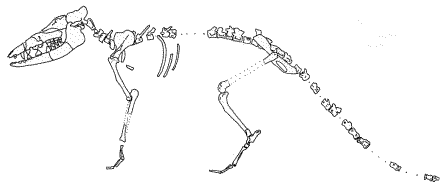
One evolutionist website made the picture below to represent approximately what that skeleton looked like clothed in muscle and skin.26
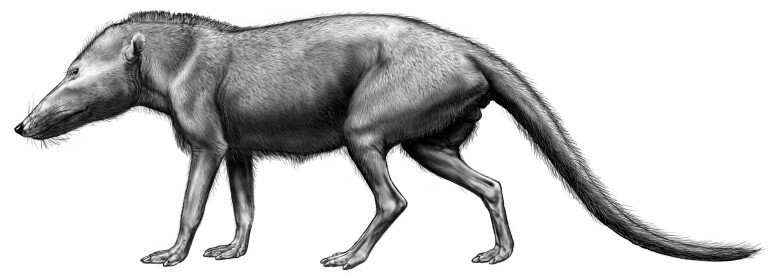
Although the authors of the technical paper in Nature said that Pakicetus is a land animal and “no more amphibious than a tapir” [a pig-like creature], the title of the article calls it a “terrestrial cetacean,” which, translated, means “a whale or dolphin or porpoise that lives on the land.” But that is just evolutionist, deceptive double-talk based on wishful thinking. There are no living “terrestrial cetaceans,” and there is no fossil evidence presented in the Nature article or any other evolutionist publication that such creatures ever existed in the past. It is deceptive to have such evolutionized names for these fossils, e.g., Pakicetus, “terrestrial cetaceans,” etc. At the end of Gingerich’s 1983 article on Pakicetus, he did reveal an important truth: “Science emerged from a philosophically motivated enquiry into the nature of our world, and it has usurped some of the mystery formerly included in religion.”27
But the story of the Pakicetus deception does not end here. Consider seven minutes in one of Dr. Mortenson’s illustrated lectures which reveals this deception in 2004–2011 at the evolution website run by one of our most prestigious universities: the University of California, Berkeley.28
There are more reasons we should not trust evolutionary interpretations about the fossil record. For 200 years, evolutionists have been relying on a fundamental assumption to determine when particular creatures came into existence, when they went extinct, and which creatures lived together at the same time. That fundamental assumption was the basis for saying in the early nineteenth century that most of the geological record was formed millions of years before man was created. The assumption can be stated simply as “the absence of evidence is evidence of absence.” In other words, if a particular creature is not found fossilized in a particular rock layer, it is “proof” that the creature did not exist when that layer was formed. So, evolutionists contend, the fact that humans are not found fossilized in the same rock layers with trilobites or in the rock layers with dinosaurs proves that humans didn’t live when those creatures existed. This assumption is also influencing Dr. Kurt Wise’s thinking in proposing that whales descended from creatures that walked off the ark (discussed here), since whale fossils have not been found in the pre-Paleogene layers that many YEC geologists think are flood-deposited layers.
Absence of Evidence Is Not Evidence of Absence
There is demonstrable evidence that this fundamental evolutionist assumption is false.29 First is what are called living fossils. These are creatures that in many cases have been declared by evolutionists to have gone extinct millions of years ago because, as we come up through the sedimentary rock layers, at some point they disappear from the rocks. Then years or decades after this claim of extinction, they find the same creature essentially unchanged and still alive today. But no evolutionist believes that the creature actually went extinct and then evolved into existence again looking just like its “ancient” ancestors. The absence of evidence in supposedly millions of years’ worth of rock layers is not evidence of the nonexistence of the creatures during all that supposed time. They are often called “Lazarus taxon.” Over a hundred examples can be given. Here are just a few.30
- For decades, evolutionists said that coelacanths went extinct 65 million years ago, because above that level in the geological record there were no coelacanth fossils. The absence of evidence was considered evidence of absence, until 1938 when they found the fish swimming off the coast of Madagascar.
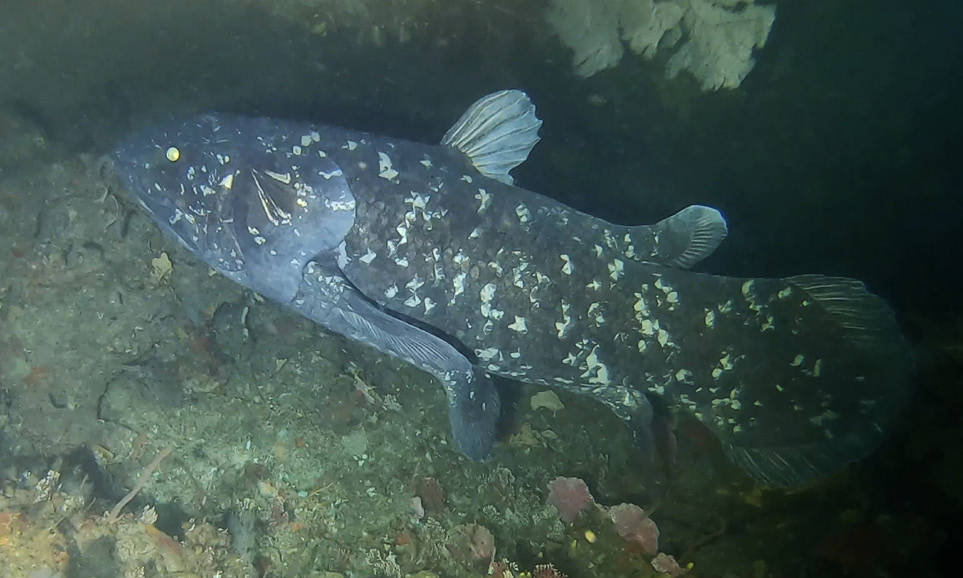
Image credit: Bruce A.S. Henderson, via Wikimedia Commons
- The Wollemi Pine was claimed (on the basis of the fossil record) to have gone extinct 150 million years ago, until 1994 when scientists found the living tree in a secluded valley in Australia not far from where the fossils were found.

Image credit: Architeuthis Dux, via Wikimedia Commons
- A class of mollusks, Monoplacophora, was believed to have gone extinct about 380 million years ago, until 1952 when they were found alive.
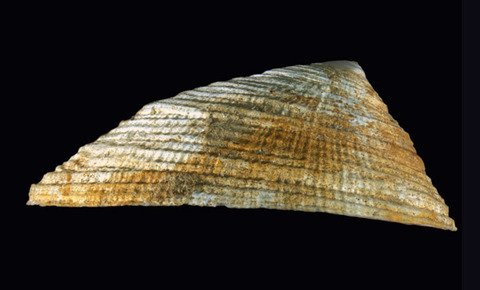
Image credit: Eric A. Lazo-Wasem, via Wikimedia Commons
- Gracilidris, a genus of ants, was thought to have gone extinct 15–20 million years ago but was found alive in 2006.

Image credit: April Nobile, via Wikimedia Commons
- “Little mountain monkey” was thought to have gone extinct 11 million years ago, until it was recently found alive.

Image credit: José Luis Bartheld, via Wikimedia Commons
Not only do scientists find creatures alive that were absent from the fossil record and therefore thought to be extinct, but they also find creatures deeper in the fossil record than previously thought; therefore, evolutionists have to change their story about when the creature evolved into existence.
This is frequently reported in the news. Just one example is the horseshoe crab. Horseshoe crabs living today are virtually identical to those in the fossil record. Based on the fossil evidence, they were long thought to have evolved into existence about 345 million years ago, until they were found in rocks evolutionists dated to be 445 million years old.31
Evolutionists use the idea that absence of fossils means nonexistence when it supports their theory and then ignore the principle when it does not support the theory. For example, we are told, “Flowering plants may have evolved 250 million years ago, more than 100 million years earlier than the oldest fossilised flowers so far found. . . . The oldest angiosperm fossils so far found are 135 million years old, and many researchers believe this is when the group originated.”32 The absence of evidence is not evidence of absence.
Similarly, Harvard evolutionist Ernst Mayr reasoned, “The fossil record of the earliest plants is very poor. Fossils of mosses, generally considered the most primitive of the living land plants, have been found from the Devonian period, but surely they existed earlier and did not fossilize.”33 Mayr assumed that mosses existed earlier than we find them fossilized because the evolution theory demands it (see the chart below).

Image Credit: Answers in Genesis
So the absence of evidence is not evidence of absence when it doesn’t support the theory. But he undoubtedly would have cried foul if he knew creationists asserted that humans existed at the same time as the trilobites found in the Cambrian rock layers (because the Bible teaches humans were created one literal day after all sea creatures), even though no humans are found in the Cambrian formation (that evolutionists claim to be about 500 million years old), as illustrated below.

Image Credit: Answers in Genesis
The Order of the Fossils: More Unreliable Than We Might Think
While there is a very general order of the fossils in the geological record, it is not nearly as nice and tidy as the evolutionists depict in their charts. It is far more complex, given the fact of Lazarus taxons and creatures showing up deeper in the record than previously thought. Also, rock layers that are in different areas of the world are given the same “age” based on index fossils (which are mostly shelled creatures). But there are huge problems with classifying these creatures in any evolutionary order, as has been shown since the early 1800s.34
While there is a very general order of the fossils in the geological record, it is not nearly as nice and tidy as the evolutionists depict in their charts.
Given the truth of Scripture, which clearly teaches young-earth creation (which is foundational to the gospel), we can confidently say that evolution and millions of years are a lie. The fossil record (which testifies of death, disease, extinction, and other natural evils) is bearing witness to earth history since the fall of Adam (Genesis 3) a little more than 6,000 years ago. It is impossible that the fossil record depicts the history of the development of life over millions of years. It is most logical to conclude that most of that fossil record is evidence of Noah’s flood.
But it is simply inconceivable that the catastrophic and complex yearlong flood, with an ascending phase of 40–150 days (when the whole earth was finally covered with water) and the 221-day retreating phase, would just naturally bury creatures (to become fossils) in an order that supports evolution over time. The only way the flood could do that is if God supernaturally guided the burial of billions of plants, animals, and people in such a way that “fair-minded” scientists would think of evolution and millions of years. But it is contrary to the nature of the truthful God in Scripture to think that he would control the burial of creatures in this way. God does not lie (Numbers 23:19) or deceive (1 Peter 2:12), and he does not lead people to believe lies (unless they hate the truth, see 2 Thessalonians 2:11–12).
So while there is a general pattern of fossils that is consistent with the flooding of the world, the pattern must be and is far more complex than evolutionists’ charts (example below) depicting life beginning as “primitive” bottom-dwelling sea creatures that eventually evolved into fish, then amphibians and reptiles, then birds and mammals, and eventually humans.
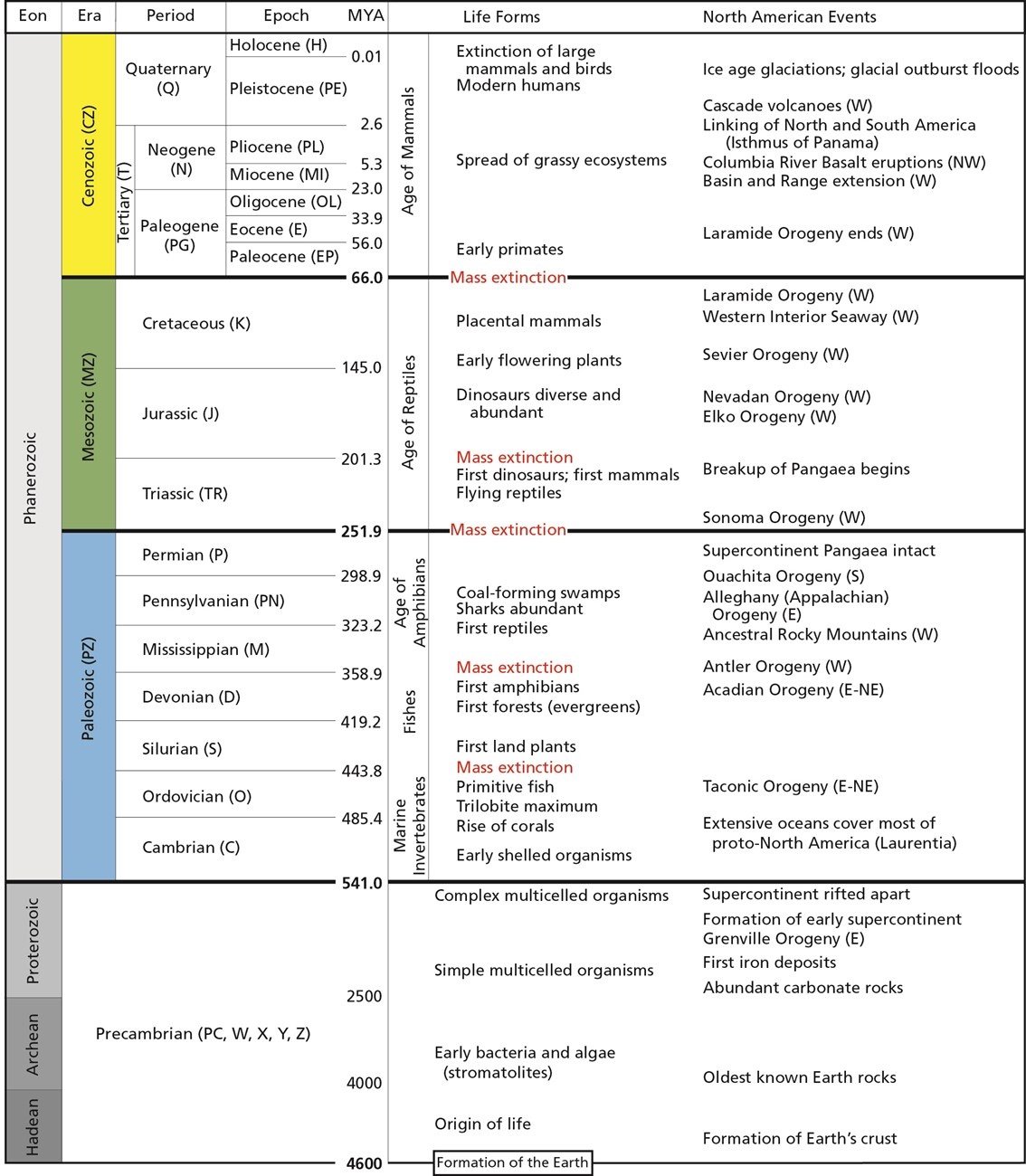
Image Credit: NPS.gov
The evolutionary charts are based on anti-biblical naturalistic assumptions. New fossil discoveries continually require evolutionists to modify their claims about when creatures first came into existence.
Finally, and briefly for here, there is another reason why Christians, especially creationists, should have considerable skepticism and scrutinize evolutionist claims about the fossil record. The uniformitarianism that controlled geology for 140 years (about 1830–1970) has been challenged and modified by evolutionary neo-catastrophists (as well as by YEC geologists).35 Statements by two leading evolutionary geologists of the twentieth century should be kept in mind. Derek Ager (1923–98), long-time professor of geology at University College, Swansea (Wales) and author of 4 books on geology and 200 scientific papers, said in 1981,
My excuse for this lengthy and amateur digression into history is that I have been trying to show how I think geology got into the hands of the theoreticians [in context, Ager has in mind the early nineteenth century uniformitarians] who were conditioned by the social and political history of their day more than by observations in the field. So it was—as Steve Gould put it—that Charles Lyell “managed to convince future generations of geologists that their science had begun with him.” In other words, we have allowed ourselves to be brainwashed into avoiding any interpretation of the past that involves extreme and what might be termed “catastrophic” processes.36
And it’s not just geology students who have been brainwashed. The whole world, including theologians, have been brainwashed too through the schools, museums, media, national parks, etc. Similarly, Gordon Davies, a well-known professor in the Department of Geography at Trinity College in Dublin, Ireland, informed us in 1993,
We are rewriting geohistory. . . . We live in an age of neocatastrophism. . . . Surely what we know as geohistory originates not within rocks but within the minds of their human observers. As a creation of the human intellect, our geohistories may owe more than is commonly supposed to processes acting within our own cerebra.37
Antibiblical, philosophical (non-scientific) assumptions in the mind have an enormous influence on the interpretation of the geological and fossil evidence. Creationists need to discern this, expose it, and refute the false claims based on those assumptions. And they need to be on guard against those ideas and the false claims subtly being introduced into creationist thinking.
In his dialogue with Falk, Wood remarked,
As for me, I am confident that Genesis 1–11 does give a general account of the earliest events of the history of creation. If that’s so, then certain scientific models (like evolution or the big bang theory) must be re-interpreted. We also need to recognize that evolutionists have come up with a lot of data that on the surface makes a strong case for their theory. Instead of dismissing it, we need to come up with a better explanation of the data. We need to ask honest questions and search hard for the answers. If we have not evolved from apes, why did God make us with such strong resemblance to apes? If Neanderthals are not our cousins, then what are they? If light from distant stars doesn’t confirm that the universe is billions of years old, what does it tell us? These are legitimate questions that creation scientists should be asking. As a scientist who believes the Bible is true, I am not bothered by the evidence for evolution. Rather, it encourages me to try to understand what’s really going on in God’s creation, because I believe if we are faithful, God will always lead us to the truth. Whatever the answers are to these complicated questions of science and Genesis, I always come back to my simple faith in God’s word. If I accept what Darrell is saying, then I have to admit that a very clear part of Scripture doesn’t mean what it actually says. So how can I be certain that any of the rest of it means what it says? It’s far easier for me to explore all the other ways of reading the data of science than to overturn a clear passage of Scripture.38
But evolution and the big bang theory must not be “reinterpreted”; they must be refuted. Dr. Wood is right that “evolutionists have come up with a lot of data that on the surface makes a strong case for their theory.” Yes, on the surface, i.e., before you scrutinize it, it seems like a strong case. But it’s not all “data”; much of it is interpretation of data, based on antibiblical and non-scientific assumptions. We do need to ask honest questions and search hard for answers. Wood says creation scientists should be asking many questions, like the examples he stated. But YECs have been doing that for over 60 years, since Morris and Whitcomb published The Genesis Flood (1961). Dr. Wood gives the impression in this 2019 book that creationists haven’t asked these questions.
Now, it’s doubtful we can know all the reasons why God made apes with some similarities to humans, but we do know that there is what is called an economy of design for creatures that share the same earth, air, plants, modes of reproduction, etc. Furthermore, apes do not have a “strong resemblance” to us.39 And YECs have had, and have published for decades, strong evidence to say that Neanderthals were fully human descendants of Adam just like we are.40
YEC physicists have been working hard on the distant starlight question for decades and have come up with many potential solutions. We don’t have proven answers yet, but evolutionists have essentially the same problem, as Dr. Wood should know.41
Similarly, YEC geologists have been trying to develop sophisticated models of the flood and figure out what the radioactive isotopes in the rocks (without the many assumptions old-earthers use) are telling us (since, clearly, they are not telling us the true age of the rocks).
YEC biologists have likewise done in-depth research on many questions and published that research in creationist technical journals for decades. And this kind of research is ongoing.
Dr. Wood’s remark seems to imply that research hasn’t been done yet, but it has and is being done. However, Dr. Wood is correct that we can’t abandon the clear teaching of Genesis, and we are glad he has not.
Conclusion
There are not lots of transitional forms, contrary to what Todd Wood says.
There are not lots of transitional forms, contrary to what Todd Wood says. The leading evolutionists say such fossils are extremely rare or nonexistent, and the ones they do cite do not stand up to scrutiny. They are examples of evolutionists reading their evolutionary imagination into the evidence.
In his dialogue book with Darrel Falk, Wood repeatedly expressed his love and respect for Dr. Falk and his enjoyable fellowship and prayer with him. But he also said that theistic evolution is “dangerous” and Christian evolutionists “are harming the church” (30), that theistic evolution “fiddles with the faith” and that rejecting the clear history of Genesis 1–11 is a “slippery slope” to rejecting the resurrection of Christ and will “unravel” the whole fabric of Christian theology (32), that it is “damaging to the church” (35), that theistic evolution is “incompatible with Christian theology” (106), and that it is “challenging the foundations of the Christian faith” (169).
We at Answers in Genesis and other YECs are concerned about fuzzy “YEE” language about evolution, evidence, and data. We are concerned about creationists who are embracing some evolutionary assumptions and interpretations of data. Because they hold to a young creation, we see this as a subtle danger that is leading Christians astray (particularly young people who study at YEC Christian colleges where these YEE ideas are being expressed). And knowing from history how easily others have slid down the slippery slope, we are concerned that such seemingly insignificant errors will, if left unchallenged and uncorrected, lead many more Christians and even whole schools and churches astray.
We also need to point out some disturbing things that are said on the back cover of Wood and Falk’s dialogue book, The Fool and the Heretic. Dr. Marcus Ross, then director of the Center for Creation Studies at Liberty University and part of this group of YEEs, wrote, “Todd and Darrell present us with their take on this vital and, at times, difficult debate. They do so with conviction and forcefulness coupled with humility, love, and a commitment to the Lord and His Word.”
But given their diametrically opposed views of the foundational chapters of Genesis and given that they call each other’s views “dangerous” and “harming the church,” they cannot both have humility and a commitment to the Lord and his Word. Only one of them is right about the origin and age of the creation: Dr. Wood. The other one, Dr. Falk, is in rebellion against the Lord and his Word.
The other endorser on the back of the book is Dr. Deborah Haarsma, president of BioLogos, the leading promoter of theistic evolution which in Wood’s words is “unravelling the fabric of Christian theology.” She says, “This book shows the hard work needed to love one’s enemy and seek the unity of believers. This is the authentic dialogue that our churches need today.”
But there can be no biblical unity without unity about the truth of God’s Word. Theistic evolutionists reject the truth of Genesis 1–11. This book is not an example of the dialogue needed in churches, and Dr. Wood’s example in this book is not one to follow. It just confuses Christians.
Dr. Wood’s confession at the end of his contribution to this dialogue book with Darrel Falk is commendable in many ways. It seems genuinely humble and transparent, and that is refreshing in today’s world. We pray that he will extend that same attitude toward this critique. But his remarks also add to our concerns.
I have to confess that I’ve been pretty terrible at Christian unity. Some might even think I’m a hypocrite with what I’m writing. I’d guess that many of my fellow young age creationists would describe me as divisive. As I write this, I imagine some whom I’ve offended are verbally scoffing at me as they read these words. I have not practiced forbearance or kindness in the past toward those who disagree with me. I still struggle every time I read or hear a fellow Christian declare with unflagging confidence that some nonsense is true and solves the whole creation-evolution debate. And I am sorry. I want my experience with Darrell to be my experience every time a fellow believer and I disagree about creation. I don’t want to be that obnoxious jerk anymore. I don’t know if that’s realistic, but I know that destructive conflict requires two people. I don’t have to be the second one. I don’t have to stoke the fires of culture war. I want to spread the good news of the gospel: in the midst of human brokenness, Jesus offers salvation. As I talk with Darrell about our deepest disagreements, I’ve experienced that gospel for myself. It’s intoxicating. I am not very good at it, but I want this unity in Christ to become the pattern of my life. I hope you’ll join me.42
There are so many troubling thoughts here, but we will only comment on one. Before Jesus prayed for unity among his followers, he prayed that they would be sanctified in the truth of his Word (John 17:17–23). Unity with those who undermine the truth and authority of the clear Word of God is not biblical unity but dangerous compromise. The Bible does teach us to love our enemies, but in context, Jesus is referring to those who are enemies of the gospel and persecutors of the church (Matthew 5:44). And he is not telling us that we should have a loving fellowship with our enemies and enjoy prayer and dialogues together. Dr. Wood may have been intoxicated by the experience of “dialogue” with Dr. Falk. But that is not an experience of the gospel. It is a deceptive experience of false unity.
Scripture tells us what to do with Christians or non-Christians who subvert the truth of God’s Word. We are to hold fast to the faithful Word, by teaching sound doctrine and refuting those who contradict (Titus 1:9). We are “to contend for the faith that was once for all delivered to the saints” (Jude 3). We are to expose false teachers (such as theistic evolutionists), even naming them as Paul did (2 Timothy 2:17–18; 3 John 9–10). Certainly, God’s Word also teaches us to refute error with humility and without ad hominem attacks. But Scripture commands us to expose and refute false teaching.
Furthermore, it’s not humility to undermine the truth of Scripture. Humility is defined by God in Isaiah 66:1–2: it is trembling at his Word. Dr. Wood is right about the Genesis account, and theistic evolutionists like Dr. Falk are wrong: Genesis 1–11 is clear, literal history, not symbolic poetry, parable, illustrative myth, or anything else. Falk and other theistic evolutionists (as well as other old-earth creationists) are arrogantly defying God’s Word. Dr. Wood needs to more forcefully resist that and expose their erroneous and deceptive teachings rather than seeking loving unity with them and speaking confusing statements about the evidence in support of evolution.
Footnotes
- Todd Charles Wood, The Quest: Exploring Creation’s Hardest Problems (Nashville, TN: Compass Classroom, 2018), 8.
- Wood, The Quest, 26.
- Wood, The Quest, 29.
- “Quibble,” Dictionary.com, accessed March 29, 2023, https://www.dictionary.com/browse/quibble.
- Wood, The Quest, 30.
- See this article to help understand the significant difference between these two kinds of science: https://answersingenesis.org/what-is-science/science-or-the-bible/.
- Charles Darwin, The Origin of Species by means of natural selection, or the preservation of favoured races in the struggle for life (London: Penguin Books, 1985, reprint of the first edition), 291–292.
- Carl O. Dunbar, Historical Geology (New York: John Wiley & Sons, 1960), 47.
- David M. Raup, “Conflicts Between Darwin and Paleontology,” Bulletin, Field Museum of Natural History, vol. 50 (January 1979), 25.
- This view says that evolution happened in small populations in a relatively short period of time and that after such significant change, a creature basically remained unchanged.
- Stephen J. Gould, “Evolution’s Erratic Pace,” Natural History 86, no. 5 (May 1977): 12–16.
- Stephen J. Gould, The Panda’s Thumb (New York: W. W. Norton, 1980), 182.
- Colin Patterson, personal letter to Luther D. Sunderland (written April 10, 1979), as quoted in Sunderland’s book, Darwin’s Enigma (San Diego: Master Books, 1984), 89.
- Steven M. Stanley, The New Evolutionary Timetable: Fossils, Genes, and the Origin of Species (New York: Basic Books, 1981), 95.
- Mark Ridley, “Who doubts evolution?” New Scientist 90 (June 25, 1981): 830–831.
- Ernst Mayr, What Evolution Is (New York: Basic Books, 2001), 14.
- Todd Charles Wood and Darrel R. Falk, The Fool and the Heretic: How Two Scientists Moved Beyond Labels to a Christian Dialogue About Creation and Evolution (Grand Rapids, MI: Zondervan, 2019), 130.
- “The genus name, Tiktaalik, comes from the Inuktitut language of the Inuit people of eastern Canada and is a general term for a large freshwater fish that lives in the shallows,” (“Tiktaalik roseae,” Britannica, https://www.britannica.com/animal/Tiktaalik-roseae, accessed March 13, 2023).
- Wood and Falk, The Fool and the Heretic, 130.
- “Tiktaalik roseae,” https://www.britannica.com/animal/Tiktaalik-roseae, accessed March 13, 2023.
- Todd Wood, “The truth about evolution,” Todd’s Blog, September 30, 2009, https://toddcwood.blogspot.com/2009/09/truth-about-evolution.html. At the end of this blog, he posts links to 11 other blog posts in which he responds to the YEC criticisms of what he said in the 2009 post.
- Wood and Falk, The Fool and the Heretic, 153.
- See Philip D. Gingerich, “Evidence for Evolution from the Vertebrate Fossil Record,” Journal of Geological Education 31, no. 2 (1983): 140–144.
- Philip Gingerich, “The Whales of Tethys,” Natural History 103, no. 4 (April 1994): 86–88.
- See J. G. M. Thewissen, E. M. Williams, L. J. Roe, and S. T. Hussain, “Skeletons of terrestrial cetaceans and the relationship of whales to artiodactyls,” Nature 413 (September 20, 2001): 277–281.
- See Carl Buell’s illustration (Reconstitution de Pakicetus) taken from https://www.researchgate.net/publication/238382256_L'origine_et_l'histoire_evolutive_des_Cetaces.
- Gingerich, “Evidence for Evolution from the Vertebrate Fossil Record,” 144.
- Terry Mortenson, “Origin of the Species Part 2,” Answers in Genesis, June 2, 2008, 00:07:25–00:13:34, https://answersingenesis.org/media/video/evolution/origin-of-species/. A shorter explanation of the same deception is in Terry Mortenson, “Deep Time Evolution Part 2” and “Deep Time Evolution Part 3,” Answers in Genesis, October 21, 2014, (from 00:15:35 in part 2 through 00:03:02 in part 3), https://answersingenesis.org/media/video/evolution/deep-time-evolution/: a lecture which further shows how anti-biblical, atheistic assumptions are controlling the interpretation of the geological and paleontological evidence.
- See Dr. Mortenson’s illustrated lecture “Deep Time Evolution,” which exposes this false assumption: https://answersingenesis.org/media/video/evolution/deep-time-evolution/.
- “Lazarus taxon,” Wikipedia, accessed March 14, 2023, https://en.wikipedia.org/wiki/Lazarus_taxon.
- Jeanna Bryner, “Oldest Horseshoe Crab Fossil Discovered,” LiveScience, January 28, 2008, accessed March 14, 2023, https://www.livescience.com/9554-oldest-horseshoe-crab-fossil-discovered.html.
- Ibrahim Sawal, “Flowering plants may be 100 million years older than we thought,” January 28, 2021, accessed March 14, 2023, https://institutions.newscientist.com/article/2266189-flowering-plants-may-be-100-million-years-older-than-we-thought/.
- Mayr, What Evolution Is, 63–64.
- For more on these critically important index fossils and how the idea of the geological column was developed in the early nineteenth century see Terry Mortenson, “The History of the Development of the Geological Column,” in The Geologic Column: Perspectives within Diluvial Geology, eds. John K. Reed and Michael J. Oard (Chino Valley, AZ: Creation Research Society, 2006), 7–30, https://answersingenesis.org/age-of-the-earth/the-history-of-the-development-of-the-geological-column/. See also Dr. Mortenson’s book The Great Turning Point on the history of the development of the idea of millions of years of earth history and how the church quickly compromised with the idea in the early 1800s.
- For a better understanding of the rise of “neo-catastrophism,” watch these four lectures:
https://www.answers.tv/defending-a-young-earth-with-dr-terry-mortenson/season:1/videos/millions-of-years-the-unscientific-origin-and-catastrophic-consequences-p1;
https://www.answers.tv/defending-a-young-earth-with-dr-terry-mortenson/season:1/videos/millions-of-years-the-unscientific-origin-and-catastrophic-consequences-p2;
https://www.answers.tv/defending-a-young-earth-with-dr-terry-mortenson/season:1/videos/noah-s-flood-and-young-earth-the-geological-evidence-p1;
https://www.answers.tv/defending-a-young-earth-with-dr-terry-mortenson/season:1/videos/noah-s-flood-and-young-earth-the-geological-evidence-p2. - Derek Ager, The Nature of the Stratigraphical Record (London: Macmillan, 1981), 46–47.
- Gordon L. Herries Davies, “Bangs replace whimpers,” Nature 365 (September 9, 1993): 115, https://doi.org/10.1038/365115a0. Davies is a well-known professor in the Department of Geography at Trinity College in Dublin, Ireland.
- Wood and Falk, The Fool and the Heretic, 112–113.
- For a recent example from 2016, examine David Menton’s and Stuart Burgess’ chapters in the in-depth, 16-author work, Searching for Adam, to see the numerous and significant differences between humans and apes.
- See Marvin Lubenow’s excellent chapter, “Neanderthals: Our Worthy Ancestors,” in Searching for Adam, which builds on his previous writings: Marvin L. Lubenow, Bones of Contention: A Creationist Assessment of Human Fossils (Grand Rapids, MI: Baker Books, 1992, and revised and expanded in 2004). See also Jack Cuozzo, Buried Alive: The Startling Truth about Neanderthal Man (Green Forest, AR: Master Books, 1998, second edition 2002).
- See Dr. Jason Lisle, “Does Distant Starlight Prove the Universe Is Old?” in The New Answers Book 1, ed. Ken Ham (Green Forest, AR: Master Books, 2006), https://answersingenesis.org/astronomy/starlight/does-distant-starlight-prove-the-universe-is-old/; also see The Heavens Declare: The Starlight Travel Dilemma, https://answersingenesis.org/store/product/heavens-declare-starlight-travel-dilemma/.
- Wood and Falk, The Fool and the Heretic, 174.
Recommended Resources

Answers in Genesis is an apologetics ministry, dedicated to helping Christians defend their faith and proclaim the good news of Jesus Christ.
- Customer Service 800.778.3390
- Available Monday–Friday | 9 AM–5 PM ET
- © 2025 Answers in Genesis

